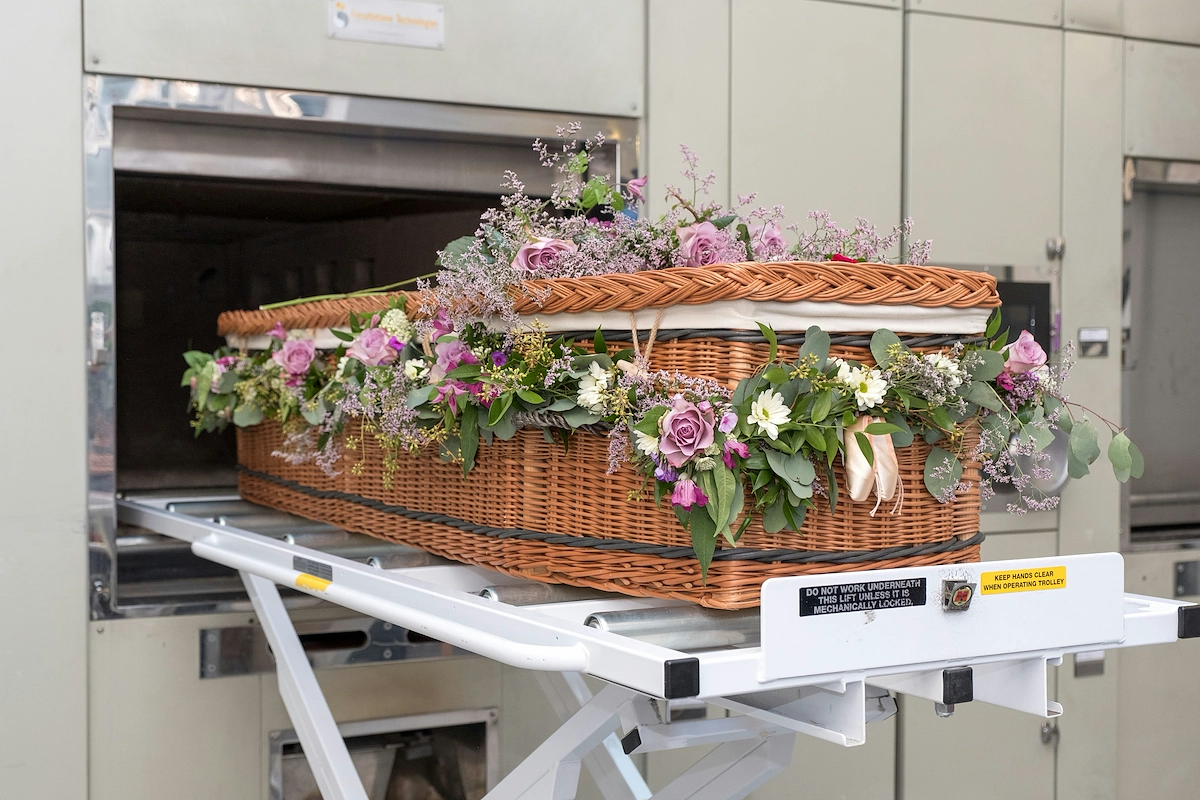Starting a cremation business is a rewarding venture that blends deep compassion with sharp business savvy. The cremation industry is a multi-billion dollar market, fueled by consistent demand from families looking for affordable options and individuals pre-planning their final wishes.
This guide will take you through the practical steps of validating your business concept, securing funding, obtaining necessary licenses, and acquiring the right equipment to help you launch a successful cremation business in the U.S.
Step 1: Create your business plan and validate the market
Start by analyzing your local market. You can access demographic data through the U.S. Census Bureau and find industry-specific trends in reports from the National Funeral Directors Association (NFDA). Look at population age, income levels, and religious affiliations in your target area.
Next, identify your direct competitors. Search the Cremation Association of North America (CANA) member directory and your state's funeral board website. Analyze their general price lists, service packages, and online presence to find gaps you can fill.
Breaking down startup costs
Understanding the financial scope helps you build a realistic plan. A cremation retort alone can cost between $80,000 and $150,000. A frequent misstep is to forget the facility modifications for proper ventilation, which can add another $50,000 to $200,000.
You should also budget for a transport vehicle ($30,000-$50,000), refrigeration units ($5,000-$15,000), and state licensing fees. Initial operating capital of $20,000-$40,000 is also a good idea to cover early expenses before revenue stabilizes.
Here are 3 immediate steps to take:
- Download the latest NFDA and CANA statistical reports to understand regional trends.
- List five local competitors and document their basic cremation package prices and services.
- Create a preliminary budget that includes estimates for equipment, facility, a vehicle, and licensing.
Step 2: Secure your legal structure and licenses
Choose your business structure
You should consider forming a Limited Liability Company (LLC). This structure protects your personal assets from business debts. Profits pass through to your personal taxes, which avoids the double taxation found in C-Corporations. You can file for an LLC through your state's Secretary of State website.
Navigate federal, state, and local requirements
With your business entity established, you can now tackle licensing. The Federal Trade Commission (FTC) enforces the Funeral Rule. This means you must provide customers with a General Price List (GPL). You do not need to file for this, but you must comply from day one to avoid fines.
Next, contact your state's funeral board for a crematory license application. Costs range from $300 to $1,000, and processing can take 60-120 days. You will also likely need a specific Funeral Director license to operate, so confirm your state's requirements.
A frequent delay is the Air Quality Permit from your local environmental protection agency. This permit for the retort can take over six months to secure, so start this process very early. Also, check with your city for specific zoning and building permits before signing a lease.
Here are 4 immediate steps to take:
- File for an LLC with your Secretary of State.
- Download the FTC's "Complying with the Funeral Rule" guide.
- Contact your state funeral board to request a crematory license application packet.
- Inquire with your local environmental agency about the Air Quality Permit process.
Step 3: Secure your insurance and manage risk
Understand your insurance needs
General liability insurance covers accidents on your property. You should also get professional liability, or E&O insurance. This protects you from claims of negligence, such as the misidentification of remains. A $1 million policy for each can cost between $2,000 and $5,000 annually.
With that in mind, you also need commercial property insurance to cover your facility and expensive equipment like the retort. If you have a transport vehicle, commercial auto insurance is mandatory. Workers’ compensation is a legal requirement in most states if you hire even one employee.
Find a specialized provider
You might want to work with an agent who understands the funeral service industry. A general agent may not grasp the specific risks or coverage you need. Consider providers like Federated Insurance, The Foresight Companies, or Homesteaders Life Company for their industry experience.
Here are 4 immediate steps to take:
- Request quotes for a $1 million professional liability policy.
- Ask potential insurers about their experience with crematory businesses.
- List all major equipment, like the retort, for your commercial property policy quote.
- Contact a specialized provider like Federated Insurance for a consultation.
Step 4: Select your location and equipment
Find the right facility
You will need a facility of at least 2,500 to 4,000 square feet. Look for properties zoned for industrial or special commercial use. Your local planning department can confirm the exact classification. Many new owners forget to check the floor's load-bearing capacity for a 20,000-pound retort.
When you negotiate a lease, aim for a term of at least 5-10 years. This gives you stability. Make sure the agreement permits significant structural modifications for ventilation and retort installation. A landlord unfamiliar with crematories might resist these terms, so be prepared to educate them.
Purchase your core equipment
Your retort is the main purchase, with prices from $80,000 to $150,000. Suppliers like Matthews Environmental Solutions or B&L Cremation Systems can provide quotes. You will also need a body refrigeration unit ($5,000-$15,000) and a processing station for cremated remains ($3,000-$7,000).
Here are 4 immediate steps to take:
- Contact your local planning department to verify zoning for a crematory.
- Request equipment quotes from suppliers like Matthews Environmental Solutions.
- Ask a structural engineer to assess the floor load capacity of potential properties.
- Review potential lease agreements for clauses allowing facility modifications.
Step 5: Set up your payment processing
Most crematories require payment in full before services are rendered. You should be prepared to accept credit cards, debit cards, and checks. For pre-need arrangements, you will often set up installment plans, so your payment system needs to handle recurring billing.
Many new owners get caught by payment processors with high transaction fees and monthly hardware costs. Look for a solution with transparent pricing. Average commission rates from other providers can range from 2.5% to 3.5%, which adds up quickly.
For a business that needs to accept payments on-site or on-the-go, JIM offers a streamlined solution. With JIM, you can accept debit, credit, and digital wallets directly through your smartphone. Just tap and you are done.
At just 1.99% per transaction with no hidden costs or extra hardware needed, it's particularly useful for collecting payment during at-need arrangements at a family's home.
- Get Started: Download JIM app for iOS
- Make a Sale: Type the sales amount, hit sell, and ask your customer to tap their card or device on your phone
- Access Funds: Your money is available right on your JIM card as soon as the sale is done - no waiting for bank transfers
Here are 3 immediate steps to take:
- Draft your standard payment policy, specifying that payment is due before services.
- Compare the total cost of two payment processors, looking at transaction rates and monthly fees.
- Download the JIM app to see how it works on your phone.
Step 6: Secure your funding and manage finances
With your business plan ready, you can approach lenders. The Small Business Administration (SBA) 7(a) loan program is a solid option. These loans can go up to $5 million. You will generally need a credit score above 680 and a 10-20% down payment.
You might also consider conventional bank loans, though they can be stricter. A better path is often a lender specializing in the funeral industry. They understand the business and are less likely to undervalue your equipment when you apply for financing.
Plan your working capital
Beyond equipment loans, you need operating cash. A frequent miscalculation is underestimating the first six months of expenses. Budget for $50,000 to $100,000 to cover payroll, utilities, and marketing before your revenue stream is consistent.
Here are 3 immediate steps to take:
- Request an SBA 7(a) loan information packet from your local SBA office.
- Identify two lenders with experience in the funeral service industry.
- Create a detailed six-month operating budget to calculate your working capital needs.
Step 7: Hire your team and set up operations
Build your core team
You will likely start with two key roles. A certified Crematory Operator handles the retort and processes remains, with salaries typically between $40,000 and $60,000. You will also need a Funeral Arranger to meet with families and manage paperwork, earning around $50,000 to $75,000.
Many states require your operator to have a certification, like the one from CANA. A frequent misstep is to hire someone without this credential, which can lead to compliance issues. Always verify your state funeral board's specific requirements before you make a hire.
Streamline your daily workflow
To manage cases, you should use industry-specific software. Programs like Passare or Halcyon help you track decedents, schedule cremations, and manage documents. This ensures a clear chain of custody, which is vital for avoiding errors and building trust with families.
As you grow, a good benchmark is to have one full-time operational employee for every 75 to 100 cremations per year. This ratio helps prevent staff burnout and maintains a high standard of service. Understaffing is a quick way to create mistakes.
Here are 4 immediate steps to take:
- Check your state board’s website for crematory operator certification rules.
- Draft job descriptions for a Crematory Operator and a Funeral Arranger.
- Request a demo from a management software provider like Passare.
- Outline your internal chain of custody procedure from intake to return of remains.
Step 8: Market your services and acquire customers
Build relationships with community partners
Your most valuable marketing comes from professional referrals. Focus on building trust with hospices, nursing homes, and hospitals. Schedule brief, in-person meetings to introduce your services and leave behind professional materials with clear contact information and pricing.
Many new owners overlook clergy and estate planning attorneys. These professionals are often the first point of contact for families. A simple introduction can lead to consistent referrals over time. This relationship-based approach has a very low customer acquisition cost.
Establish your online presence
A professional website is your digital front door. It must be easy to navigate and display your General Price List (GPL) clearly. Families under stress will leave a site that makes them hunt for information. This transparency builds immediate trust.
You should also claim and optimize your Google Business Profile. This ensures you appear in local map searches. Encourage families you have served to leave reviews. Positive testimonials are incredibly powerful for this type of business.
Here are 4 immediate steps to take:
- List five local hospices and three nursing homes to contact for an introduction.
- Draft a simple, one-page brochure with your services and prices.
- Create and fully populate your Google Business Profile.
- Design a clear pricing page for your website that is easy to find.
Step 9: Set your pricing strategy
Common pricing models
Most crematories offer a direct cremation package as a baseline service. A typical price is $795 to $1,195 and includes basic transport, the cremation process, and a simple container for the remains.
From there, you can build tiered packages. A mid-tier option at $1,595 might add an urn allowance and help with death certificate paperwork. A premium package could include a small family viewing before the cremation.
Calculate margins and analyze competitors
Your direct cost per cremation, including fuel and labor, will likely be $200 to $350. At a $995 price point, this leaves a gross margin of 65-80% to cover your overhead and generate profit.
Many new owners make the mistake of setting prices based only on competitors. Instead, start with your costs. You can research competitors by calling them and requesting their General Price List. They must provide it to you by law.
Here are 4 immediate steps to take:
- Calculate your estimated direct cost for a single cremation.
- Create three service packages with clear price points and inclusions.
- Call three local competitors to obtain their General Price Lists for comparison.
- Set a target gross profit margin for your direct cremation service.
Step 10: Maintain quality and scale your operations
Establish your quality standards
Your reputation rests on a perfect chain of custody. The non-negotiable standard is zero misidentifications. You can enforce this with weekly internal audits of all case files, cross-referencing ID tags and paperwork at every stage.
To measure service quality, you might send a simple post-service satisfaction survey to families. Aim for a 95% or higher satisfaction rate. This feedback provides direct insight into the family's experience and highlights areas for improvement.
Know when to grow
As your case volume increases, use clear benchmarks for expansion. A good rule of thumb is to hire one new operational employee for every 75-100 additional annual cremations. This ratio helps prevent staff burnout and service delays.
Many owners wait too long to hire, which often leads to mistakes. Once you see a steady three-month increase in case volume, start the hiring process. For equipment, a single retort can handle about 1,000-1,200 cremations a year. Plan for a second unit when you reach 80% capacity.
With growth, case management software like SRS Computing or Passare becomes invaluable. These systems help manage a higher case load and more staff while maintaining a flawless chain of custody across the board.
Here are 4 immediate steps to take:
- Create a weekly chain-of-custody audit checklist for your case files.
- Draft a simple, 3-question satisfaction survey to send to families post-service.
- Set a case volume target, like 800 annual cases, to trigger planning for a second retort.
- Schedule a demo with a management software provider like SRS Computing to review its features for scaling.
Starting a cremation business is about more than logistics. Remember that your compassion and attention to detail are what families will value most. This focus on service is your true foundation. You have the roadmap, now go build a business that truly serves your community.
Making things easy for families is part of great service. A simple payment solution like JIM lets you accept cards on your phone for a flat 1.99% fee, with no extra hardware. This helps you focus on the family, not the payment. Download JIM.















